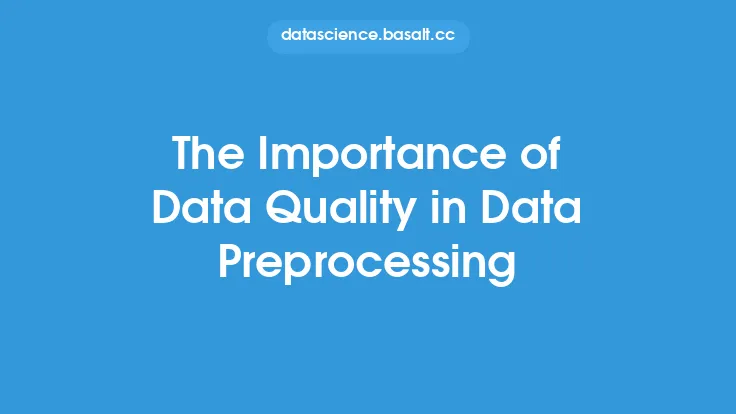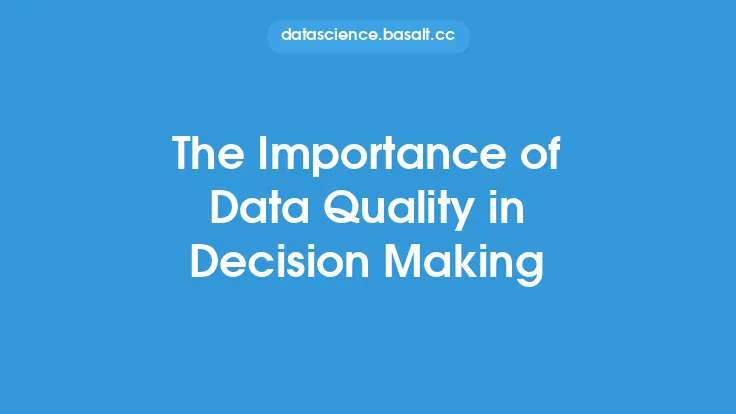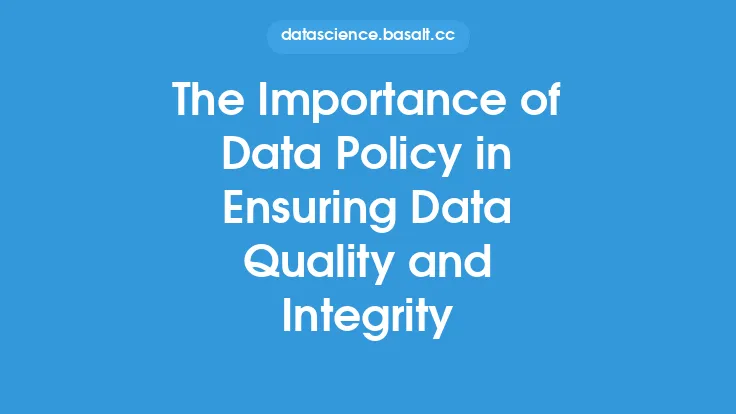Data quality is the foundation of any successful data exploration endeavor. It is the process of ensuring that the data used for analysis is accurate, complete, and consistent. High-quality data is essential for making informed decisions, as it provides a reliable basis for analysis and interpretation. In the context of data exploration, data quality is critical because it directly impacts the validity and reliability of the insights and patterns discovered.
Introduction to Data Quality
Data quality refers to the degree to which data is accurate, complete, consistent, and reliable. It is a multifaceted concept that encompasses various aspects, including data accuracy, completeness, consistency, and timeliness. Data quality is not a one-time achievement, but rather an ongoing process that requires continuous monitoring and improvement. It is essential to establish a data quality framework that outlines the standards, policies, and procedures for ensuring high-quality data.
The Consequences of Poor Data Quality
Poor data quality can have severe consequences, including incorrect insights, flawed decision-making, and wasted resources. Inaccurate or incomplete data can lead to incorrect conclusions, which can have far-reaching consequences. For instance, a business may make strategic decisions based on flawed data, resulting in financial losses or damage to its reputation. Moreover, poor data quality can also lead to decreased productivity, as analysts and data scientists spend more time cleaning and preprocessing data rather than analyzing it.
Data Quality Dimensions
Data quality can be evaluated along several dimensions, including accuracy, completeness, consistency, timeliness, and relevance. Accuracy refers to the degree to which data is free from errors and reflects the true values. Completeness refers to the extent to which data is comprehensive and includes all the necessary information. Consistency refers to the degree to which data is uniform and follows a standard format. Timeliness refers to the degree to which data is up-to-date and reflects the current situation. Relevance refers to the degree to which data is pertinent to the analysis or decision-making process.
Data Quality Assessment
Data quality assessment is the process of evaluating the quality of data against established standards and criteria. It involves identifying and measuring data quality issues, such as errors, inconsistencies, and missing values. Data quality assessment can be performed using various techniques, including data profiling, data validation, and data verification. Data profiling involves analyzing data to identify patterns, trends, and correlations. Data validation involves checking data against predefined rules and constraints. Data verification involves comparing data against external sources to ensure accuracy.
Data Quality Improvement
Data quality improvement is the process of taking corrective actions to address data quality issues. It involves identifying the root causes of data quality problems and implementing solutions to prevent them from recurring. Data quality improvement can be achieved through various strategies, including data standardization, data normalization, and data cleansing. Data standardization involves establishing common formats and standards for data. Data normalization involves transforming data into a consistent format. Data cleansing involves removing errors, duplicates, and inconsistencies from data.
Data Quality Metrics
Data quality metrics are used to measure and evaluate data quality. They provide a quantitative basis for assessing data quality and tracking improvements over time. Common data quality metrics include accuracy rate, completeness rate, consistency rate, and timeliness rate. Accuracy rate measures the percentage of accurate data. Completeness rate measures the percentage of complete data. Consistency rate measures the percentage of consistent data. Timeliness rate measures the percentage of up-to-date data.
Best Practices for Ensuring Data Quality
Ensuring data quality requires a combination of people, processes, and technology. Best practices for ensuring data quality include establishing a data quality framework, defining data quality standards, and implementing data quality controls. A data quality framework outlines the policies, procedures, and standards for ensuring data quality. Data quality standards define the criteria for evaluating data quality. Data quality controls involve implementing checks and balances to prevent data quality issues.
The Role of Technology in Data Quality
Technology plays a critical role in ensuring data quality. Various tools and techniques are available to support data quality, including data quality software, data validation tools, and data cleansing tools. Data quality software provides a comprehensive platform for managing data quality. Data validation tools check data against predefined rules and constraints. Data cleansing tools remove errors, duplicates, and inconsistencies from data. Additionally, technologies like artificial intelligence and machine learning can be used to automate data quality processes and improve data quality.
Conclusion
Data quality is a critical aspect of data exploration, and it is essential to ensure that data is accurate, complete, consistent, and reliable. Poor data quality can have severe consequences, including incorrect insights and flawed decision-making. By understanding the dimensions of data quality, assessing data quality, and improving data quality, organizations can ensure that their data is fit for purpose and supports informed decision-making. By following best practices and leveraging technology, organizations can establish a robust data quality framework that supports their data exploration endeavors.





